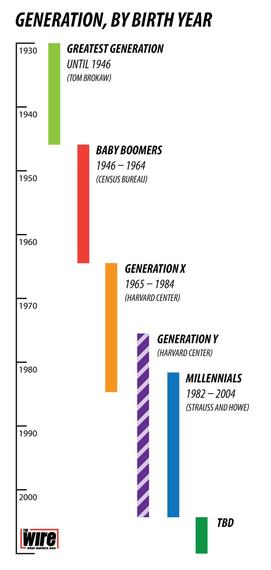If you are leading individuals from multiple "generations," you are probably categorizing them incorrectly, and here is why this is bad for you and your business.
There are 78 million pages returned from a Google search for "leading generations." Almost 5000 books are available on Amazon.com around leading generations, and in the scholarly realm a search across a few academic databases returned almost three million peer-reviewed articles, dissertations and journal entries all on "leading generations."
I am going to go out on a limb and estimate that we have approximately half a billion pages written on leading generations. Most of this around the Baby Boomers, Generation X, Generation Y and the Millennial Generation.
Here is the problem; most of these half a billion pages categorize humans into generations based on when they were born. The generations are most times described as seen in the image below.
This image is the courtesy of The Atlantic in an article titled "Here Is When Each Generation Begins and Ends, According to Facts."
We have approximately half a billion pages written on leading generations.
Seems rational right, lets figure out what motivates these generations, what types of followers are they, what type of leadership theory works best for each generation, and what types of leaders would result form each generation.
Well, no.
As I continue to be a nerd and read hundreds of those half a billion pages in preparation for my dissertation, a once fuzzy hunch of mine, has crystalized into a design principle I now use as modus operand.
Belonging to a generation has nothing to do with when you were born.
The theory of generations has been historically researched under two branches of views. Familial and cohort views. Familial generations are those described as "kids of the previous generation." This is mostly what is in the diagram above. Cohort generations are people regardless of their age that have affinity to a modality or memory of a set of shared experiences. The Great Depression, The Industrial Revolution, The Internet, 9/11, and the invention of the iPhone.
Grand parents, parents, and children can all be in the same cohort generation; but obviously from different familial generations.
This is a key change in thinking, and starts to create questions challenging the chart above as an oversimplification of a single human, and can largely misinform leadership in the private and public sector.
Here is why I wrote this blog.
Recognizing that using cohort association to identify someone's generation is good, but realizing that a single human can change from one generation to another over time is really where the kicker is.
Principal Analyst, Alan Lepofsky from Constellation Research will tell you that there are no age boundaries when it comes to enterprise social. He has seen as many of the young reject social as many of the old embrace it.
On Alan's position, and in tandem with my research I have started to apply a new set of lenses to an individual when I think about what "generation" they may be in, and then how to lead them appropriately.
I know many folks my age who have shorter attentions span than most from the Facebook generation.
I know many folks over 55 that are more social and digital than my 16-year-old nephew. And I know many teenagers who study and read the classics more than my uncles and aunts ever do or did. I know many folks my age who have shorter attentions span than most from the Facebook generation, and I know many folks over 60 who are more entrepreneurial than any 21-year-old currently driving to Silicon Valley with a Mac Air and some hoodies in a Subaru.
So what is a leader to do?
- Understand an individual's digital competency.
- Understand how an individual sees entrepreneurial activity.
- Understand how he or she sees sharing and collaboration.
- Study how they view rapid iteration.
- Understand how they see the role of a leader, servant, participative, or transformational.
- Then, and only then put them into a generation, and regardless of their age (or gender) lead.
I write as a labor of love, in exchange I ask that you share this writing if you think others may find value,
-Richie

